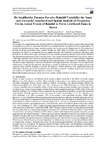Do Smallholder Farmers Perceive Rainfall Variability the Same and Correctly? Gendered and Spatial Analysis of Perception Versus Actual Trends of Rainfall in Three Livelihood Zones in Kenya

View/
Date
2018Author
Kiumbuku, Samuel Kimani
Baaru, Mary Wamuyu
Mutinda, Jane Wanza
Metadata
Show full item recordAbstract
In this paper we compared perceived rainfall variability with actual rainfall variability using a more nuanced and mixed approach in order to understand the influence of gender dynamics and spatial location on perceptions. To be able respond effectively to climate variability people must first perceive the changes correctly. Past studies have focused on general perceptions about climate changes but have failed to ascertain the correctness of these perceptions as well as to exhaustively focus on gender dynamics and livelihood expectations that shape these perceptions. To address these gaps we focused on a more nuanced comparison between actual climate variability and gendered perception across three livelihood zones. We obtained historical Rainfall data from weather stations in the three livelihood zones which we analysed using Coefficient of Variance (CV) and Cumulative Departure Index (CDI). We then compared this with responses from inter-household survey data of 420 households that were stratified in stages depending on the zones and gender of the target respondents. Although it was not significantly different how women and men perceived the changes in rainfall (p-value above 0.05) men seemed to perceive the variations more correctly compared to women. All aspects of rainfall variability were significantly perceived differently in the three agricultural livelihood zones. Depending on specific livelihood expectations in each zone the variability of rainfall was either perceived correctly or wrongly.
